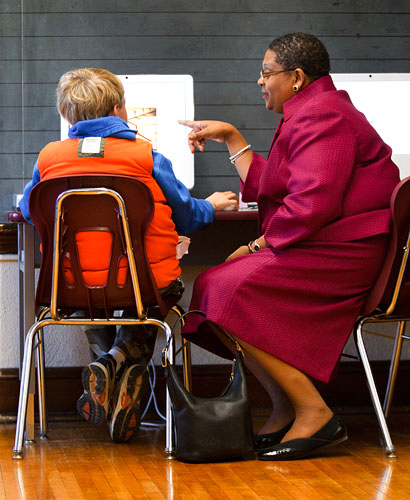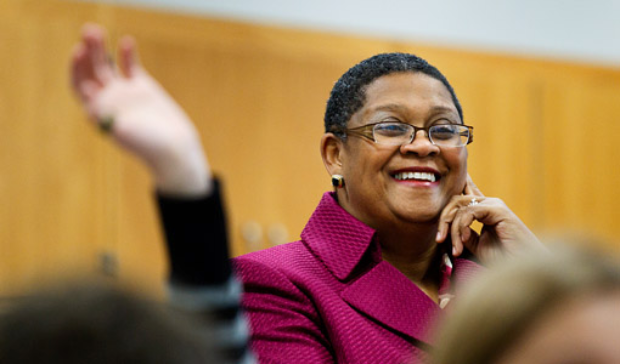Bernadeia Johnson has a frenetic – some would say crazy – schedule. She works 12-hour days as superintendent of Minneapolis schools, starting with coffee shop meetings at dawn and often running well into the evening with community meetings. In between, there is a constant flurry of issues involving curriculum, policies, budgets, personnel and politics.
She stays sane and remains grounded by remembering why she is really in the job. It’s not just to run a $685 million, 34,000-student, 5,600-employee operation. It’s to carry out the responsibility that is so perfectly described on the nameplate on her desk:
Bernadeia Johnson
Every Day
Every Child
“It’s so easy to not individualize this work,” Johnson said late one Friday afternoon, on her 51st birthday, as she sat in her office and reflected on another frenetic and crazy week. “You have to carry the images of individual kids and remember that the decisions you make affect not 34,000 children – but individual kids.”
That’s why Johnson is following five kindergarten students – out of 3,100 in the school district – to see how they are reading. The goal is to reach a certain performance level by winter break. She gets regular progress reports, stays in touch with parents and blogs about the project.
That’s why Johnson visits a school most Tuesdays and sometimes Thursdays. She often arrives unannounced to spend time in classrooms watching teachers work with students on everything from how to tell time to discussing the differences between X-rays and MRIs.
And that’s why Johnson is willing to endure seemingly endless criticism from the public when she makes controversial recommendations such as closing North High School, a community anchor for 122 years. Her bottom line: the school isn’t doing a good enough job in educating students and has lost far too many students to remain effective.
On days like this, Johnson finds herself a long way from her hometown of Selma, Ala., where she attended segregated schools until fifth grade … from the financial analyst job that she held at a bank in the 1980s … and from her first teaching assignment after deciding to change careers and enroll in the new Collaborative Urban Educator (CUE) program at St. Thomas.
Frenetic or crazy, Johnson wouldn’t have it any other way because she believes she can – and she will – make a difference in providing a better education for 34,000 children. One at a time.
“The role we play in educating students is central,” said Johnson, who last July 1 became the seventh person in a decade to serve as Minneapolis superintendent. “We are the one – the one – institution open to all students, and we can have the greatest impact on those students and what they will do with the rest of their lives. That is a wonderful opportunity.”
Bernadeia Johnson grew up in Selma during the height of racial unrest in the 1960s. She was the oldest of three children, and her parents – her mom was a teacher and her dad was a lobbyist for the United Auto Workers – were divorced. Integration came slow to the Deep South.
“There was no busing,” she said. “Just because the schools were integrated didn’t mean you went there, so mom paid for cabs. They picked us up every morning and drove us to the white school and back.”
 Johnson spent summers as a teenager in Minneapolis, where maternal grandmother Hallie Hendrieth-Smith taught and served as an elementary school principal for nearly three decades. A skilled clarinetist, Johnson enrolled in Alabama A&M University on a full music scholarship, played in the concert and marching bands and majored in speech pathology. She met trombonist Reginald Johnson and they married and moved to the Twin Cities. She went to work for what now is U.S. Bank, where she had held summer jobs. Her husband has spent his career in Minneapolis and Anoka-Hennepin schools as a teacher and administrator, and today is assistant principal at Olson Middle School in Minneapolis.
Johnson spent summers as a teenager in Minneapolis, where maternal grandmother Hallie Hendrieth-Smith taught and served as an elementary school principal for nearly three decades. A skilled clarinetist, Johnson enrolled in Alabama A&M University on a full music scholarship, played in the concert and marching bands and majored in speech pathology. She met trombonist Reginald Johnson and they married and moved to the Twin Cities. She went to work for what now is U.S. Bank, where she had held summer jobs. Her husband has spent his career in Minneapolis and Anoka-Hennepin schools as a teacher and administrator, and today is assistant principal at Olson Middle School in Minneapolis.
A corporate downsizing led to layoffs in 1991, and Johnson found herself without a job after 13 years at U.S. Bank. With two young children at home, she struggled to find work and filed for Chapter 13 bankruptcy.
“There was a lot of reflection time without a job,” she said. “I had to take stock in what I wanted to do. I was getting a little jaundiced about the banking business.”
Then she heard about CUE. The St. Thomas School of Education, responding to a legislative initiative for alternative teaching licensure programs, had established CUE and recruited largely from communities of color. Many students – including Johnson – were in their 30s and looking for a career change – and she caught the eye of CUE founding director Trudi Taylor.
“Bernadeia stood out,” Taylor said. “She was articulate and thoughtful. We knew she would be a great teacher. She always has had this positive, can-do attitude – for herself and everyone around her – and an amazing ability to pull people together and work together.”
Johnson flourished in the program, receiving her licensure in 1992 and her first assignment as a fifth-grade teacher at Highwood Hills School in St. Paul. It didn’t take her long to ascertain that she had made the right decision.
“I loved teaching,” she said. “I thought I was a good teacher, and I always tried to become a better teacher.”
Knowing that some educators viewed her as having taken a “back door” to her position through alternative licensure, Johnson worked even harder. She earned her master’s degree in curriculum and instruction from St. Thomas and certification from the National Board for Professional Teaching Standards, juggling course work with her duties in the classroom.
“I liked the naughty kids,” she said. “I always thought their attitudes were an expression of self and not in defiance of me. I thought I could find something in the most challenging students that they could feel good about and become successful.” She paused and laughed. “There was a little bit of defiance in me, too!”
After five years at Highwood, Johnson moved to Saturn Riverfront Academy in downtown St. Paul to intern for a year as an assistant principal and then serve in that position for a year. She had not actively considered work as an administrator but found that she liked it, encouraged by teachers who would say, “Show me what you’re doing and how you’re doing it.”
She got a call one day from Minneapolis Public Schools asking her to consider an assistant principal position, but her husband counseled her to say no. “If you are going to come to Minneapolis, you come as principal or not at all,” she recalled him saying. “So that’s what I told them.”
Somebody listened. In 1999, Johnson became principal of Elizabeth Hall Elementary School, where her grandmother had held the same position in the 1980s. She thought her granddaughter would be a good fit for the job, just as she has been a good fit as superintendent.
“She has so much to offer to young people in the way she challenges them to be the best they can,” said Hendrieth-Smith, now 94. “She always had it in her to be the best, and whatever that required, she would do it. You don’t have to tell Bernadeia what to do or where to go. She just does it.”
Reginald Johnson also believes his wife has been a good fit for her jobs, although she has needed “a little nudge,” he said. “I used to tell her all the time, ‘Bernadeia, you can do this,’ and then she gets in there and excels. She can do anything she sets her mind to. She’s that good. She’s that driven.”
 The Hall position, which Johnson held for five years, challenged her. There was divisiveness among the faculty and staff, too many students fought and performance scores were low. She created safe zones and encouraged people to come to her for “tuneups.”
The Hall position, which Johnson held for five years, challenged her. There was divisiveness among the faculty and staff, too many students fought and performance scores were low. She created safe zones and encouraged people to come to her for “tuneups.”
“I told them, ‘You can come to me for a tuneup. You can say whatever you want as long as you are respectful. Do you want to listen? To problem solve? To take action?’ One person said she found me intimidating. It blew me away. I said, ‘Wow,’ and asked why. I said, ‘Let’s do this: I’ll go away and think about my role, and you do the same.’”
They got back together, compared notes and began to get along better. Johnson later told the staff how she had had her own “tuneup” and learned a great deal from it.
In 2004, Carol Johnson, the former Minneapolis superintendent who had taken the same job in Memphis, called Johnson with an assistant superintendent offer. She moved and within five weeks was deputy superintendent. She served 16 months before taking another call – from Minneapolis superintendent Bill Green – and returning as deputy superintendent in charge of academics.
When Green decided to leave last year, the Minneapolis School Board chose not to conduct a national search but name Johnson as his successor. “I am just humbled and honored,” she said at the time. “I’m nervous and excited all rolled into one.”
It’s Election Day, and Johnson is sitting in Dunn Brothers Coffee in south Minneapolis for her weekly meeting with Minneapolis School Board Chairman Tom Madden and deputy superintendent Dan Loewenson. It’s their chance to review hot issues – and none is hotter than Johnson’s recommendation to close North High School.
Johnson has been buried in criticism about the closing of 122-year-old North, where enrollment dropped 75 percent – from 1,140 in 2004 to 265 today – as students fled for charter schools or suburban districts. Seeking a compromise, Johnson came up with a new plan: close North by 2014 and open a new North in 2012 as a 500-student magnet school.
She reviews her strategy with Madden and Loewenson, starting with a news conference to announce the plan and the board’s vote. They discuss key points to address in both settings, and Johnson vows to move forward. “I wish I didn’t have to do this,” she said, “but it’s the right thing to do.”
Two days later, the news conference draws a big crowd, including Mayor R.T. Rybak. Johnson deftly handles tough questions and challenges the community to join her in designing the new North, promising to bring together “the intellectual horsepower” of educators, government officials, businesses, alumni, parents and students.
“This is about guaranteeing Minneapolis families that no matter where you live or what your income is or what your background is, your child will get the same educational opportunities as other students,” she told the news conference. “Being able to get into a high-quality school should not be like winning the lottery. This is about delivering excellence.”
Five days later, the board approves Johnson’s plan – with one caveat. She recommended the phase-out of old North begin without enrolling freshmen in 2011, but the board decides to allow one more freshman class.
As stressful as issues like the North closing can be, Johnson always has the perfect place to escape for a break and to remind her why she took her job. She goes to school.
On this day, after the Madden-Loewenson meeting, Johnson visits Hale and Field schools. They are “twinned” schools, Hale as a K-4 and Field as a 5-8. Her first stop is Tracey Schultz’s eighth-grade science class, where students are discerning chemical reactions between elements. Later, other students compare X-rays and MRIs, and Schultz tosses in EEGs to enrich the discussion.
“You do so well in science here,” Johnson tells the students. She had received letters from parents praising Schultz and decided to see her in action. “I just wanted to know what works well.”
Johnson’s next stop is at Hale, a mile away, where first-graders are learning to tell time. “We didn’t even make one mistake!” one girl tells Johnson. Down the hall, fourth-graders pack a 36-Macintosh laboratory, and Johnson crouches next to a boy to watch him work on a math problem. All of this is done unannounced, with Johnson sliding in and out of classrooms. The practice is unnerving in one sense, admits Steven Norlin-Weaver, in his fourth year as Field principal, “but I’m not sure it’s a big deal. What are we going to do differently?”
That’s what Johnson likes to hear, she says later at lunch.
“I don’t want to go into schools to see a show,” she said, and she certainly didn’t get one in Schultz’s classroom. “The kids wanted to tell me what they were learning. They were able to communicate. There was a buzz – a real energy – in her classroom. …
“Every student engaged in an explanation of X-rays and MRIs. It was interactive. She called on students.
And if a student didn’t know an answer or got it wrong, there was an acceptance of that and a willingness to move on.”
Those experiences are affirmative for Johnson as well – and they reflect a philosophy formed over 20 years as a teacher and administrator and stated ever so simply on a nameplate on her desk:
Bernadeia Johnson
Every Day
Every Child
“As long as I remember that,” she said, “I’ll be okay.”
Read more from St. Thomas magazine





